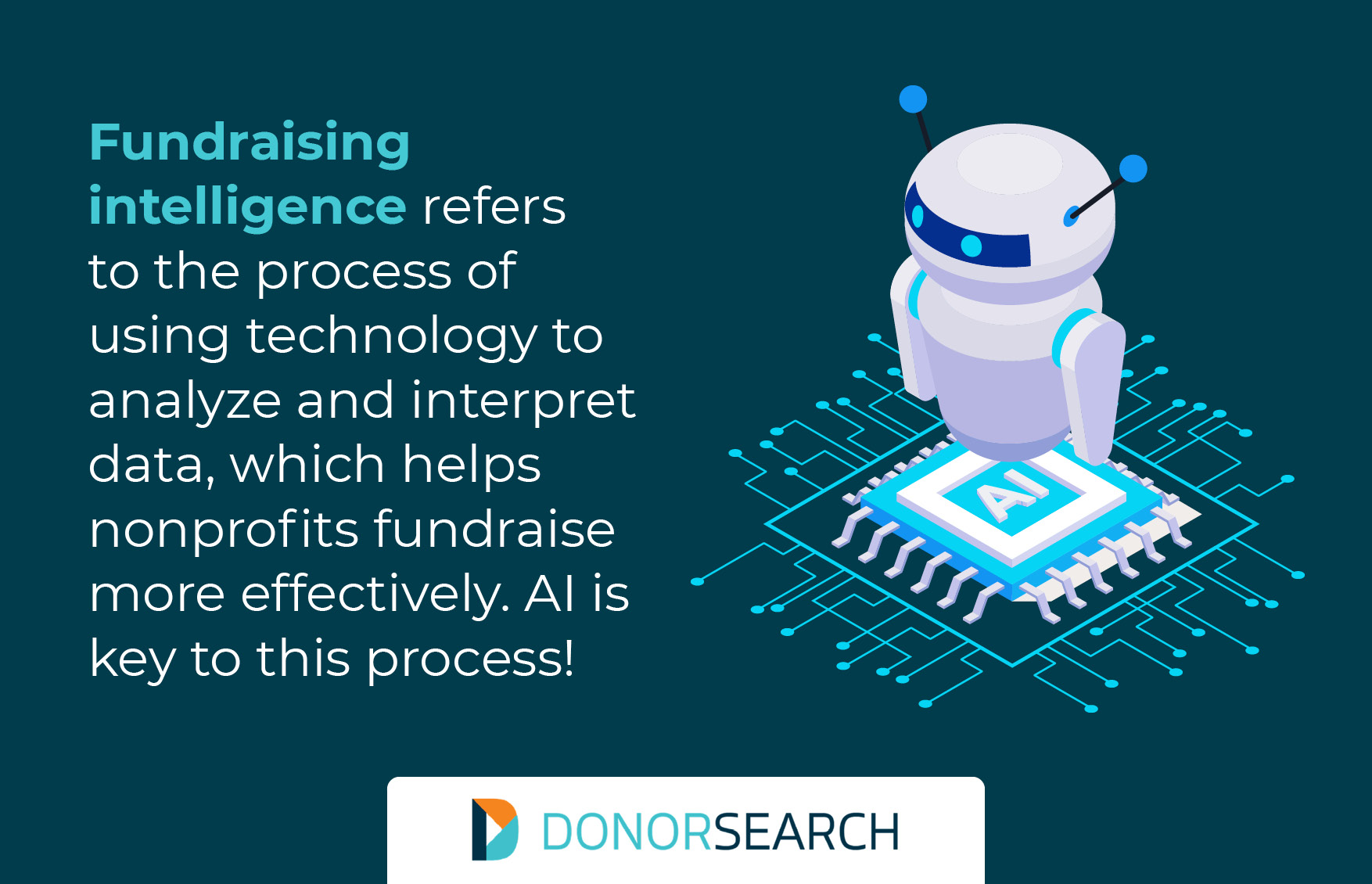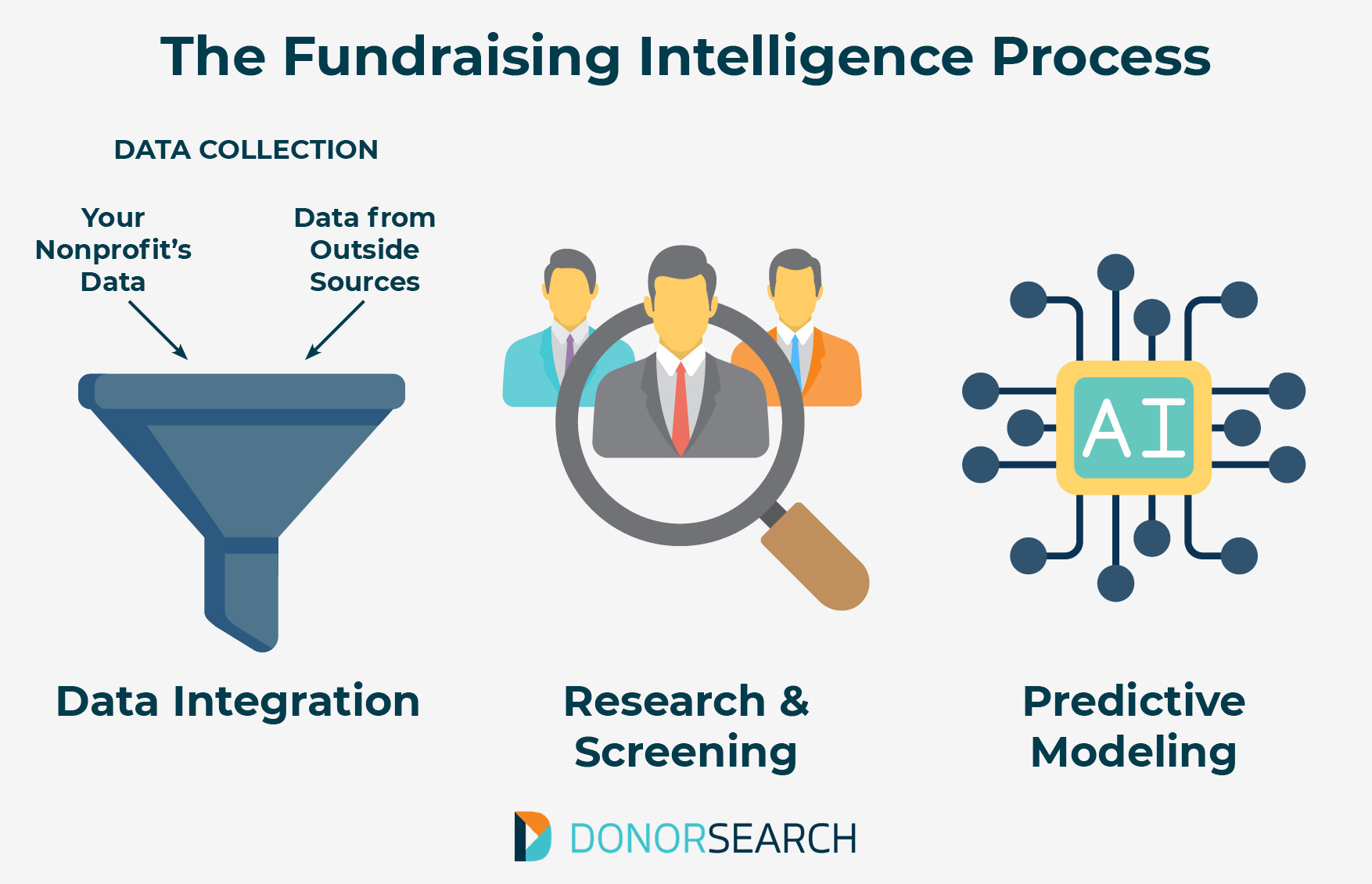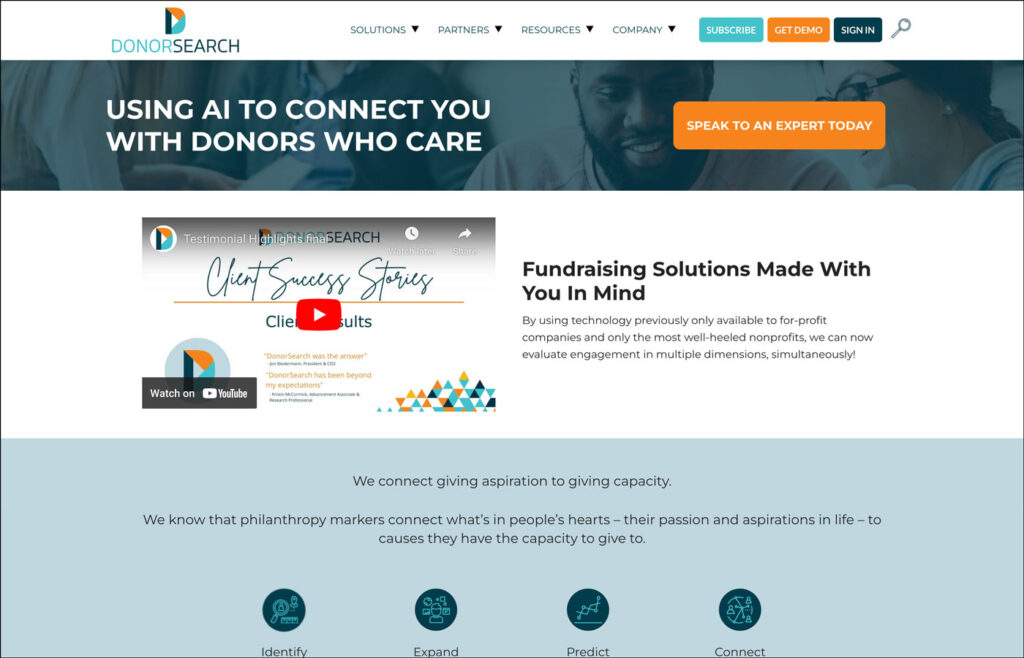
Fundraising Intelligence: Using AI to Enhance Philanthropy
One of the greatest challenges facing nonprofits today is the need to stand out from the crowd.
After all, while your nonprofit is unique, there are over 1.5 million nonprofits in the U.S. alone, meaning there are thousands of other nonprofits with similar or adjacent missions to yours competing for donors’ attention. So, how can you pull ahead and ensure your organization is set up to experience success now and in the future?
Here’s your answer: By harnessing the power of modern trends and innovations—in particular, fundraising intelligence, backed by robust artificial intelligence (AI) tools. Fundraising intelligence empowers you to use data to connect with your donors and reach your goals in smarter and more efficient ways than were previously possible.
In this guide, we’ll dive into the nitty-gritty of fundraising intelligence, covering:
- What is fundraising intelligence?
- Intelligent Fundraising: How It Works
- Putting Your Fundraising Intelligence Insights to Work: 5 Tips
AI is the new frontier, so it’s time to embrace a fundraising strategy that helps you put it into practice. If you’re ready to prepare your organization for the future and familiarize yourself and your team with fundraising intelligence, this is the guide for you.

What is fundraising intelligence?

Fundraising intelligence refers to the process of using technology to analyze and interpret data, which helps nonprofits fundraise more effectively.
It can be thought of as a fundraising methodology or framework that goes beyond basic data collection, integrating artificial intelligence (AI) strategies. AI-driven insights then help to take your analysis and interpretation capabilities to the next level, infusing your fundraising programs with increased efficiency and accuracy. Specifically, AI can:
- Quickly process large amounts of donor data and data from external sources
- Make specific predictions and recommendations about donors and prospects
- Equip you with insights you need to build genuine connections with donors and prospects
While learning about fundraising intelligence, you may come across the term “business intelligence.” You can think of business intelligence as fundraising intelligence’s for-profit counterpart. Simply put, business intelligence is the use of data and robust technologies that help businesses make data-driven decisions.
Why Your Nonprofit Should Use Fundraising Intelligence
The overarching benefit of fundraising intelligence is that your nonprofit experiences a competitive advantage. With data on your side, you can be more confident in your decisions and your ability to reach out to donors who are willing and ready to give. This ensures that your organization makes a lasting impression and stands out from the crowd.
You’ll also experience a number of other benefits when leveraging fundraising intelligence, such as:
- Increased fundraising revenue. As you use the right tools to help make sense of your data and reach out to high-impact donors, your nonprofit will be able to pull in more fundraising dollars.
- Data-driven decision making. Fundraising intelligence takes the guesswork out of fundraising. Insights pulled from your data can help guide your decision-making so that you can be confident in your next strategic move.
- More personalized interactions with supporters. More and more, nonprofit supporters are expecting personalized experiences with their favorite organizations. Fundraising intelligence can put you ahead of the curve when it comes to getting to know your donors, their reasons for being interested in your work, and their preferences for engagement.
- Internal team efficiency. Tapping into fundraising intelligence, especially the AI tools that make it easy to interpret data and make predictions, can save your internal team a lot of time. This time can be reinvested in other important work, allowing you to make the most of your team’s talents and ensure your organization is operating smoothly.
- Stability. When your nonprofit experiences more success in its fundraising efforts, your organization can focus on thriving instead of just surviving. This means you can put more time and resources toward accomplishing long-term goals and growing your organization.
Clearly, fundraising intelligence is worth weaving into your current fundraising strategy because it expands your organization’s capacity to achieve its fundraising goals and puts you in a position to grow your operations. But how do you begin? First, you’ll need to understand the fundraising intelligence process.
Intelligent Fundraising: How It Works
The end goal of using fundraising intelligence is to more effectively and efficiently build connections with your donors and prospects, leading to greater returns on all your fundraising efforts. But what goes into a strong fundraising intelligence strategy? Let’s explore the process:

- Data collection. Intelligent fundraising begins with data—and lots of it. You already have data on your donors in your CRM (as well as from other tools like surveys, web analytics platforms, volunteer management tools, etc.), but you’ll need to supplement that data with information from trustworthy outside sources. The right databases and providers can offer details like individuals’ giving patterns and behavior, capacity details, engagement behavior, demographic characteristics, and social media activity.
- Data integration. Next, you’ll need to pull all of your data into one place. This will help you get a holistic view of who your donors are as individuals and what they need from your organization to be inspired to give.
- Prospect research and screening. You’ll look for affinity, propensity, and capacity markers that denote that an individual cares about your specific organization, is philanthropically minded, and is in the position to give a donation. When someone exhibits all three types of markers, you can be confident you’ve found a viable prospect or donor to reach out to.
- Predictive modeling. Go a step further with prospecting and screening by using a tool with predictive modeling capabilities. You can use these types of tools to predict specific donor behaviors, such as who is likely to make their first donation soon and who is likely to give over a certain amount.
The insights you gain from this process make it possible to dive into deep segmentation, strategic campaign planning, and outreach work (more on this below).
The key to this process is having the right tool in your toolbox, one that you can rely on for accurate, actionable insights.
The AI Tool You Need for Intelligent Fundraising: DonorSearch Ai
DonorSearch Ai, the most advanced machine learning solution for the nonprofit sector, can help you in your journey to harness the power of fundraising intelligence.

Here’s how it works. DonorSearch Ai brings together your nonprofit’s donor data along with DonorSearch’s industry-leading datasets to identify potential donors and donors who may be ready to give again. But it doesn’t stop there. Using predictive modeling, it provides specific predictions and recommendations about individuals to guide your fundraising efforts.
DonorSearch has long been trusted as a leader in donor research. But DonorSearch Ai brings a new edge to DonorSearch’s traditional screening and prospecting capabilities, putting you a step ahead in your outreach and relationship-building processes.
Plus, DonorSearch is deeply committed to the responsible use of AI, meaning that the DonorSearch team recognizes both the risks and benefits your nonprofit can encounter when using AI tools. We prioritize data privacy, inclusiveness, transparency, legal compliance, and continuous learning when it comes to using AI. This means you can be extra confident about shielding your organization and its community from risk when you use DonorSearch Ai.
Check out our explainer video to learn more!
Putting Your Fundraising Intelligence Insights to Work: 5 Tips
Once you have insights about your donors and prospects from the intelligent fundraising process, it’s time to put them to good use. Use these tips to get your organization on the road to fundraising success:
- Practice deep segmentation. One of the best marketing strategies for fundraising campaigns is to practice segmentation, the process of catering your messaging to specific groups of supporters. Your intelligent fundraising insights allow you to go deeper with segmentation, considering multiple factors as you work to tailor your communications. After all, you have more information, so why not use it? For example, instead of grouping donors by donation amount or frequency alone, you might take into consideration event attendance and hours volunteered, too, getting you even closer to sending the right people the communications that will truly resonate with them.
- Personalize your outreach. Since fundraising intelligence helps you gather a variety of data points for each individual, you have all sorts of information at your fingertips that you can use to easily personalize your outreach work. This can extend beyond addressing a donor by name to referencing past contributions and involvement or even specific interests or concerns.
- Put in the time to build relationships. Once you have your foot in the door with a donor or prospect, use the insights from the intelligent fundraising process to build a relationship. This will take time. In fact, research shows that it takes 50 hours to transition from acquaintance to friend, or in this case, trusted nonprofit contact! Schedule regular interactions and use what you’ve learned about each individual to get to know them better and discover more about why they care about your work.
- Invite donors to engage. Once you have a natural opportunity to issue an initial invitation to engage with your organization, take it. Make sure to personalize your invitation by waiting for an opportunity that you know the individual will respond to. For example, if you know that a prospect really enjoys spending time outside, you might invite them to your next park cleanup. Or, if you know a major donor who is a retired educator and passionate about learning, you might invite them to read your most recent blog post about your tutoring program.
- Personalize your donation asks. When the time comes to make a donation ask, use what you know about your donors’ and prospects’ giving capacities and affinities to make a specific, personalized donation request. You should ask for a specific donation amount and explain what the donation will be used for, also sharing why you need that specific donor’s support.
The beauty of using intelligent fundraising insights is that they set your organization up to not only secure donations but to retain your donors for the long run as you build lasting relationships with each person. Make sure as you continue to learn about your donors throughout this process that you record further insights in your donor profiles to reference in the future.
Final Thoughts
Fundraising intelligence can set your nonprofit apart from the competition, helping your organization get ahead in the fundraising game by providing a holistic view of who your donors are and how to engage them. Use this guide to start tapping into the power of fundraising intelligence, and remember that the right AI tools will make all the difference in your efforts to get to know your donors better.
Ready to learn more about the world of fundraising? Check out these recommended resources:
- AI Fundraising for Nonprofits: Embracing the New Frontier. AI is the latest and greatest in fundraising technology. Learn more about how to harness it in your own strategy.
- A Complete Guide to Planned Gifts for Nonprofits. Planned gifts are an important source of fundraising revenue for nonprofits, but how robust is your own organization’s program? Check out this explainer to learn more.
- Fundraising for Healthcare Institutions: The Basics to Know. Fundraising for healthcare institutions presents a unique set of challenges. Learn how to navigate the healthcare landscape in this guide.
- Grateful Patient Programs: 3 FAQs & How to Get Started. Grateful patient programs are critical for the health of healthcare institutions’ philanthropy efforts. Learn how to start your own program in this guide.

